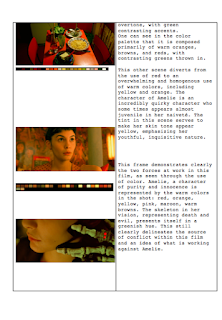In the making of Small, Indifferent Neena there were a variety of factors that went into its completion. I took on the role of director and so I worked on getting a couple of the necessary releases.


These are examples of a location release and a talent release. The first major step in making this film was brainstorming the idea and then writing the script. Our genre was a road film. Unfortunately, due to the restrictions of the school building and school day, the use of a car was not feasible. Therefore, we decided to zero in on the tradition of a notable method of traveling by giving our protagonist crutches. Additionally, we subverted the genre due to our protagonist. In road films, the protagonist is conventionally a white male. Not only is our protagonist a woman, she is also a person of color which aids in the subversion of this genre. After the script was complete, the storyboard was easy to complete. Around this time, I got releases from the actors and the property manager of the school. Then, it was mostly the production process of organizing actors, technology, and locations. It wasn't until post-production that we truly applied the new skill of color correction and color grading. This was a really interesting process and I feel like it was a huge success in upping the quality of our film. If I were to do the project again, I would try to use a consistent microphone throughout for volume consistency.


These are examples of a location release and a talent release. The first major step in making this film was brainstorming the idea and then writing the script. Our genre was a road film. Unfortunately, due to the restrictions of the school building and school day, the use of a car was not feasible. Therefore, we decided to zero in on the tradition of a notable method of traveling by giving our protagonist crutches. Additionally, we subverted the genre due to our protagonist. In road films, the protagonist is conventionally a white male. Not only is our protagonist a woman, she is also a person of color which aids in the subversion of this genre. After the script was complete, the storyboard was easy to complete. Around this time, I got releases from the actors and the property manager of the school. Then, it was mostly the production process of organizing actors, technology, and locations. It wasn't until post-production that we truly applied the new skill of color correction and color grading. This was a really interesting process and I feel like it was a huge success in upping the quality of our film. If I were to do the project again, I would try to use a consistent microphone throughout for volume consistency.




















